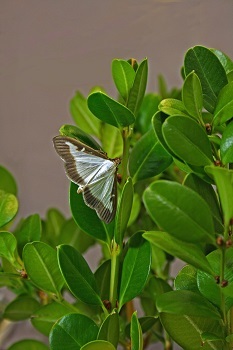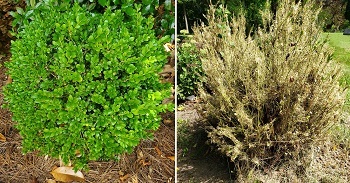|
The following news release was issued earlier today by the Michigan Department of Agriculture and Rural Development.
For immediate release: November 7, 2022
Program contact: Andria McCubbin, 517-599-5748
Media contact: Jennifer Holton, 517-284-5724
LANSING, Mich -The U.S. Department of Agriculture’s (USDA) Animal and Plant Health Inspection Service (APHIS) has confirmed the detection of box tree moth (BTM) (Cydalima perspectalis) at two residences in Clinton located in Lenawee County. Although not a threat to Michigan’s natural resources, extensive feeding from box tree moth can lead to significant defoliation and death of ornamental boxwood.

In May 2021, potentially infested boxwood plants were shipped to retail locations in several states including six in Michigan. The pest was then identified in three of the six Michigan facilities. It is not known whether the box tree moth populations detected in Clinton are linked or if the pest entered the state through another pathway.
“Box tree moth poses a serious threat to our boxwood industry,” said Mike Philip, Pesticide and Plant Pest Management Division Director with the Michigan Department of Agriculture and Rural Development. “We are in the assessment stage of this response, and we are asking Michiganders to look closely at their boxwood plants and report any signs of this pest so we can determine the scope of this infestation and work to reduce the spread.”
|

Box tree moth caterpillars are green and yellow with white, yellow, and black stripes and black spots. The caterpillars feed only on boxwoods making them easy to spot. Adult box tree moth has two color forms. The most common form has white wings with dark brown borders, while the dark form has solid brown wings with a white streak or spot on each forewing. Both forms have a distinctive white dot or mark in the middle of each forewing.
Box tree moth may not be easily recognized at the beginning of an infestation because young larvae hide among twigs and leaves. Signs of infestation include chewed, cut, or missing leaves, yellowing or brown leaves, white webbing, and green-black excrement on or around the plant. Larvae skeletonize the leaves and feed on the back, causing defoliation and dryness, eventually leading to the plant’s death.
|
“MDARD is developing a survey plan to further determine the extent of the infestation,” added Philip. “But Michiganders can be a tremendous help by being on the lookout for box tree moth and reporting it.”
What you can do:
- Check your boxwood plants for signs of box tree moth.
- If you see signs of box tree moth, please take a photo and report suspects online.
- Let state and federal agriculture officials inspect your boxwood for box tree moth.
- If a new population is confirmed, you may be directed to remove infested branches or, for heavy infestations, cut the boxwood from its base (it should grow back from its roots). Discard all boxwood debris by double-bagging it in plastic and putting it with your household trash.
Visit Michigan.gov/Invasives or Michigan.gov/Invasives/ID-Report/Insects/Box-Tree-Moth to find photos and additional information about box tree moth and other invasive plant pests.
For more information about PPPM visit Michigan.gov/MDARD/Plant-Pest. You may also contact Michigan State University Extension for additional resources on box tree moth at CANR.MSU.edu/Tag/Box-Tree-Moth.
Michigan's Invasive Species Program is cooperatively implemented by the Department of Environment, Great Lakes, and Energy: the Department of Natural Resources; and the Department of Agriculture and Rural Development.
/Note to editors: Accompanying photos are available below for download. Suggested captions follow.
BTM: Box tree moths are generally white with a brown border and a white “comma” on each forewing.
Boxwood comparison: A healthy boxwood (left) compared to a boxwood heavily damaged by box tree moth caterpillars.
|